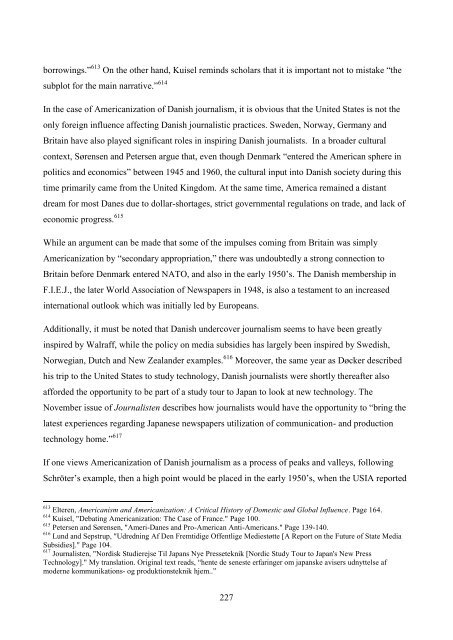The Jeremiad Over Journalism
The Jeremiad Over Journalism
The Jeremiad Over Journalism
You also want an ePaper? Increase the reach of your titles
YUMPU automatically turns print PDFs into web optimized ePapers that Google loves.
orrowings.‖ 613 On the other hand, Kuisel reminds scholars that it is important not to mistake ―the<br />
subplot for the main narrative.‖ 614<br />
In the case of Americanization of Danish journalism, it is obvious that the United States is not the<br />
only foreign influence affecting Danish journalistic practices. Sweden, Norway, Germany and<br />
Britain have also played significant roles in inspiring Danish journalists. In a broader cultural<br />
context, Sørensen and Petersen argue that, even though Denmark ―entered the American sphere in<br />
politics and economics‖ between 1945 and 1960, the cultural input into Danish society during this<br />
time primarily came from the United Kingdom. At the same time, America remained a distant<br />
dream for most Danes due to dollar-shortages, strict governmental regulations on trade, and lack of<br />
economic progress. 615<br />
While an argument can be made that some of the impulses coming from Britain was simply<br />
Americanization by ―secondary appropriation,‖ there was undoubtedly a strong connection to<br />
Britain before Denmark entered NATO, and also in the early 1950‘s. <strong>The</strong> Danish membership in<br />
F.I.E.J., the later World Association of Newspapers in 1948, is also a testament to an increased<br />
international outlook which was initially led by Europeans.<br />
Additionally, it must be noted that Danish undercover journalism seems to have been greatly<br />
inspired by Walraff, while the policy on media subsidies has largely been inspired by Swedish,<br />
Norwegian, Dutch and New Zealander examples. 616 Moreover, the same year as Døcker described<br />
his trip to the United States to study technology, Danish journalists were shortly thereafter also<br />
afforded the opportunity to be part of a study tour to Japan to look at new technology. <strong>The</strong><br />
November issue of Journalisten describes how journalists would have the opportunity to ―bring the<br />
latest experiences regarding Japanese newspapers utilization of communication- and production<br />
technology home.‖ 617<br />
If one views Americanization of Danish journalism as a process of peaks and valleys, following<br />
Schröter‘s example, then a high point would be placed in the early 1950‘s, when the USIA reported<br />
613<br />
Elteren, Americanism and Americanization: A Critical History of Domestic and Global Influence. Page 164.<br />
614<br />
Kuisel, "Debating Americanization: <strong>The</strong> Case of France." Page 100.<br />
615<br />
Petersen and Sørensen, "Ameri-Danes and Pro-American Anti-Americans." Page 139-140.<br />
616<br />
Lund and Sepstrup, "Udredning Af Den Fremtidige Offentlige Mediestøtte [A Report on the Future of State Media<br />
Subsidies]." Page 104.<br />
617<br />
Journalisten, "Nordisk Studierejse Til Japans Nye Presseteknik [Nordic Study Tour to Japan's New Press<br />
Technology]." My translation. Original text reads, ―hente de seneste erfaringer om japanske avisers udnyttelse af<br />
moderne kommunikations- og produktionsteknik hjem..‖<br />
227
















